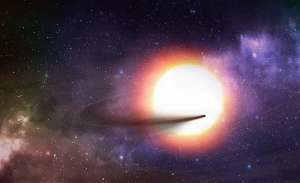Feb 20 2015
Exciting new research by astronomers at The Open University (OU) and the Universities of Warwick and Sheffield has opened up the chance to find out what distant planets are made of. The team of astronomers have made observations which can help reveal the chemical makeup of a small rocky world orbiting a distant star about 1500 light years away from Earth, increasing our understanding of how planets, including ours, were formed.
 Exoplanet KIC 1255 b orbits its parent star followed by a comet-like dust tail. Credit: Artists impression by Maciej Szyszko
Exoplanet KIC 1255 b orbits its parent star followed by a comet-like dust tail. Credit: Artists impression by Maciej Szyszko
Using a state-of-the-art, ultra-fast camera, ULTRACAM, on Science and Technology Facilities Council’s (STFC) William Herschel Telescope (WHT) the researchers have observed an extraordinary exoplanet named ‘KIC 1255 b’. "A single year on KIC 1255b lasts only 16 hours on Earth and the whole planet seems to be slowly boiling away under intense heat of its sun" said Jakub Bochinski, research student at the OU, and lead author of the study. The planet’s surface is heated to over 2100K (over 1800°C), hot enough to vapourise rock. As a result, the planet’s outer layers are continuously destroyed, with the evaporating rock creating a comet-like dust tail following the planet in its orbit.
Once every orbit, the planet and the dusty tail pass across the host star, blocking some of its light from our view. The planet itself is tiny, similar in size to Mercury - far too small to be seen on its own. The dust cloud, however, is much bigger and blocks up to 1% of the star’s light each orbit. For comparison, the largest planet in our Solar System, Jupiter, would block 1% of the Sun’s light in a similar arrangement. The dust cloud grows and shrinks in size seemingly at random, some of the time disappearing from our view completely. Five nights of the WHT observations show this variation clearly, offering a unique chance to pin down the mechanism responsible for this unusual behaviour.
The ULTRACAM measurements were the most sensitive yet made, and revealed that the dust cloud, when visible, blocks a slightly larger fraction of the star’s blue light than red light. A similar effect is seen at sunset on Earth when the Sun’s light is scattered by dust in the Earth’s atmosphere, making the remaining light appear reddened. The exact colour-dependence of the scattering by dust (measured by carrying out simultaneous, multi-colour measurements with ULTRACAM) can reveal the size and composition of the dust grains. Ultimately, a series of measurements of KIC 1255b’s dust cloud could reveal the chemical composition of the dust.
Since the dust is made from the rocky surface of the disintegrating planet, the same technique will allow the chemical makeup of the planet’s surface to be measured. The team will attempt to make these first exogeological measurements with further observations in summer 2015. Jakub Bochinski added: “This is an incredibly exciting breakthrough as it opens up the possibility of determining the chemical composition of this rocky planet. By doing that we can find out how typical our solar system is, helping us learn more about how Earth and other planets were formed.”
The paper Direct evidence for an evolving dust cloud from the exoplanet KIC12557548 b is published in the journal The Astrophysical Journal Letters and the work was originated and supervised by Dr Carole Haswell, Senior Lecturer in Astrophysics at The Open University.